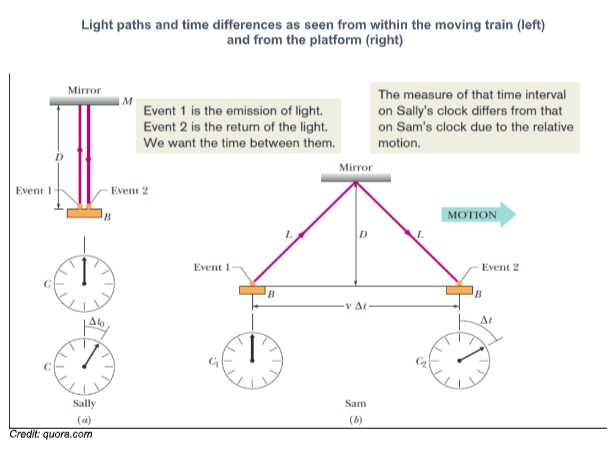Albert Einstein published four ground-breaking papers in rapid succession in 1905 in Annalen der Physik. They are his “miracle year” papers. Einstein was a clerk 3rd class at the Swiss patent office in Bern at the time, having been unable to obtain an academic appointment when he produced these papers:
(1) the photoelectric effect
(2) Brownian motion
(3) the special theory of relativity
(4) the energy content of mass (E=mc2 )
In the first paper, Einstein proposed that light transmits its energy as discrete particles or quanta and that each light quantum has a specific energy value consistent with its wavelength. This insight explained how ultraviolet light ejects electrons from a metal surface (the photoelectric effect). Einstein’s recognition of the dual wave/particle nature of light was a foundation of quantum mechanics. He received the Nobel prize for this work.
In his second paper, Einstein showed how the cumulative effect of the random motion of liquid molecules causes the erratic movement of microscopic particles suspended in the liquid (Brownian motion). This paper provided the first proof of the existence of molecules.
Einstein’s third paper, Electrodynamics of Moving Bodies, introduced the special theory of relativity. In trying to understand this theory’s concepts, I became fascinated with who Albert Einstein was and how he came to his many revelations about physical reality. For more about this, see Einstein: The Man and His Mind.
The concept of relativity of motion had been proposed almost three centuries before Einstein. Galileo had pointed out that when one object moves with respect to something else, both move relative to each other, and their velocities are additive. For example, two trains, each traveling at seventy-five miles per hour in opposite directions, are traveling one hundred fifty miles per hour relative to each other as observed by a passenger in either train. But this turns out not to be true for light.
According to Galileo, two objects traveling in opposite directions, each at 75 percent of the speed of light, would have a relative velocity of 150 percent of the speed of light. Michelson and Morley, however, showed in 1887 that the speed of light is always the same, regardless of the motion of an observer relative to the light source. Light always arrives at the constant velocity c (approximately 182,000 miles per second). This is true whether one is moving toward or away from a light source or the light source is moving toward or away from the observer. This finding contradicted Galilean relativity.
With the aid of simple thought experiments, Einstein resolved the contradiction. He reasoned that if the laws of physics and the speed of light are the same for observers in different reference frames, then time cannot be not absolute.
Imagine two synchronized flashlights mounted alongside railroad tracks equidistant to the right and left of a stationary observer on the platform. He will see the two lights flashing simultaneously. But another observer in the train will see the flash first from the light the train is speeding toward because the light has less distance to travel, and then the flash of the other light. Even though they disagree on the timing of the two flashes, both observers’ perceptions are valid.
Now imagine a light beam traveling between the floor to a mirror on the ceiling and back to the floor in the moving train. The bouncing light beam is comparable to the ticking of a clock. As seen by a passenger inside the train (Sally), the beam travels straight up and down. But, an observer on the platform (Sam) will see a longer zig-zag path for the light beam as the train speeds past. As viewed from the platform, the light beam travels a longer route, which takes more time, so the clock’s ticking slows down. Sam will see time passing more slowly on the train than on the platform.
But from Sally’s frame of reference, the platform is speeding past her, so she will see Sam’s clock slow down. This apparent paradox has made it difficult for me (and likely others) to reconcile special relativity with common sense.

Almost as an afterthought and derived from the special theory of relativity, Einstein’s fourth “miracle year” paper established the equivalence between mass and energy. This discovery led to the world’s most famous equation, E=mc2 .
The explosion of creativity embodied in these four papers within months of each other forced the transition from classical to modern physics. Any one of these papers could have qualified Einstein for a Nobel prize. It was surprising to many that Einstein received his award for the photoelectric effect, important as it was, instead of for his most significant achievement, the general theory of relativity, published ten years after his miracle year papers. For more information about this, see Einstein’s Nobel Prize Address Centennial.
For those interested in learning more about Einstein’s miracle year, I recommend Annus Mirabilis by John Gribbin and Mary Gribbin.
———————–
With its ability to reach a wide audience, from those with a special interest in Einstein to others who may have relatively little prior familiarity with the man, EINSTEIN: The Man and His Mind is a standout in Einstein literature and in researched biographical and artistic studies. This extraordinary book deserves a place not just in Einstein libraries, but also in those representing the intersection between photographic art and biography.
EINSTEIN: The Man and His Mind
Einstein: The Man and His Mind
By Gary S. Berger and Michael DiRuggiero
Available in the United States in bookstores and online.
ISBN 978-8862087841
November 2022
